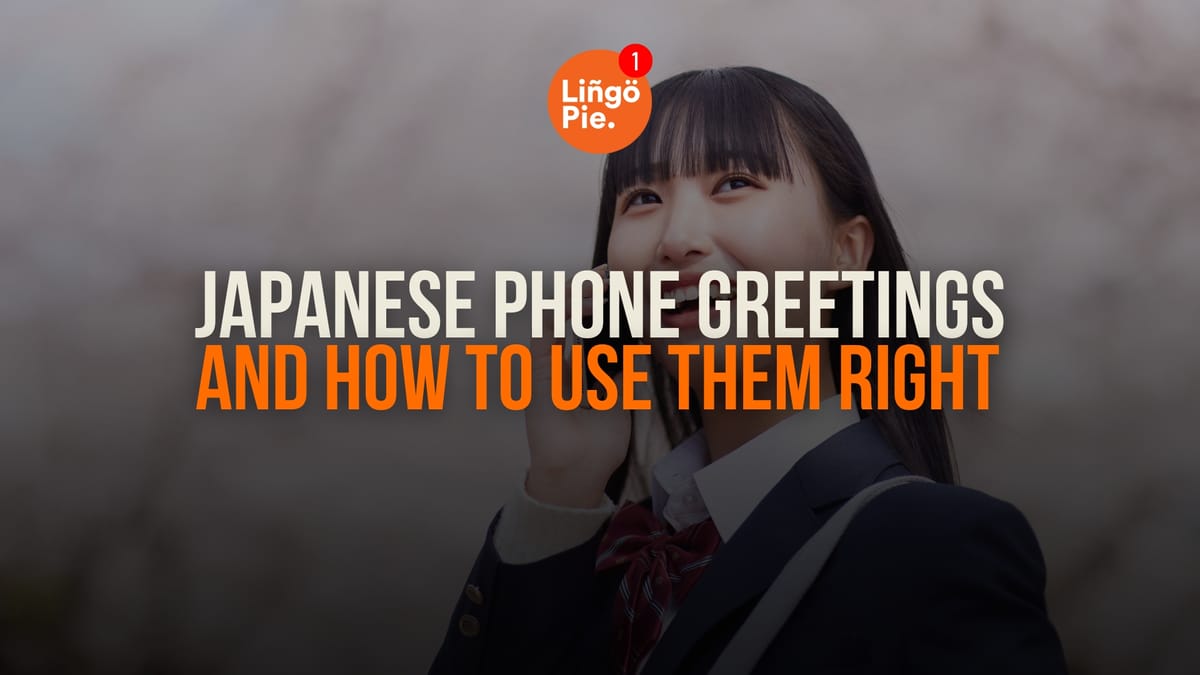If you’re planning to move to Japan or study there, being able to handle phone calls in Japanese is a skill you’ll definitely need. Sure, messaging apps like WhatsApp, LINE, and Skype are everywhere—but traditional phone calls are still very common in Japan, especially for jobs, schools, and appointments.
Whether you’re confirming a delivery, calling your landlord, or answering a potential employer, knowing how to navigate a Japanese phone conversation can save you a lot of confusion (and maybe a few awkward silences).
In this post, I’ll break down everything you need to know about Japanese phone etiquette: from the basic Japanese greetings and phrases to how a typical phone conversation flows. You’ll also learn key expressions that Japanese people actually use, plus a few practical tips to sound polite and confident when picking up the phone.
- 15 Japanese Horror Films to Watch on Halloween
- Halloween In Japan: A Gaijin's Guide To 6 Spooktacular Traditions
- Hobbies In Japanese: 50+ Words, Phrases, And Tips [2025]

Japanese Phone Etiquette
In casual situations, like calling a friend or classmate, Japanese phone etiquette is friendly but still polite. People usually start with a simple greeting like “もしもし (moshi moshi)” when answering, followed by a short self-introduction if needed. It’s common to confirm the other person’s availability with phrases like “今、大丈夫?(Ima, daijōbu?)” meaning “Is now a good time?”
In professional or formal settings, politeness is much more structured. Instead of “moshi moshi,” business calls often begin with a greeting like “お世話になっております (Osewa ni natte orimasu)” — a polite phrase meaning “Thank you for your continued support.” You should clearly state your name, company, and reason for calling. Always speak in a calm, measured tone, use honorifics, and avoid slang.
Basic Japanese Phone Greetings
もしもし (Moshi Moshi)
This is the most common way to say hello when answering the phone in Japanese. It’s used in casual or neutral situations, like between friends or when you don’t need to sound overly formal. The phrase comes from the verb mōsu (申す), a humble form of “to say,” and repeating it softens the tone. It’s not used in business calls or formal conversations.
Variations:
- もしもし、○○です。(Moshi moshi, ___ desu.) — “Hello, this is ___.”
- もしもし、聞こえますか?(Moshi moshi, kikoemasu ka?) — “Hello, can you hear me?”
もっしー (Mosshī)
A playful or shortened version of “moshi moshi,” used among close friends or young people. It sounds cute and informal, similar to how English speakers might say “hey” instead of “hello.” It’s not suitable for anyone outside your personal circle or for professional calls.
はい、___でございます。(Hai, ___ de gozaimasu)
This is a very polite and formal way to answer the phone, often used in businesses, restaurants, or offices. The structure means “Yes, this is ___,” with de gozaimasu being the most respectful version of desu (“to be”).
Examples:
- はい、株式会社リンゴピでございます。(Hai, Kabushiki-gaisha Ringopi de gozaimasu.) — “Yes, this is Lingopie Co., Ltd.”
- はい、受付の山田でございます。(Hai, uketsuke no Yamada de gozaimasu.) — “Yes, this is Yamada at reception.”
はい (Hai)
Literally means “yes,” but in phone conversations it’s also a neutral greeting or acknowledgment when answering or responding. It’s polite, flexible, and can fit most situations — casual or business — depending on tone and what follows.
Variations:
- はい、○○です。(Hai, ___ desu.) — “Yes, this is ___.”
- はい、ありがとうございます。(Hai, arigatou gozaimasu.) — “Yes, thank you.”
どちら様でしょうか。 (Dochira-sama deshō ka)
A very polite way of asking who’s calling, literally meaning “Who may you be?” (dochira-sama = “which person,” deshō ka = soft polite question). It’s often used in business settings or when speaking to someone you don’t know. Using this instead of “誰ですか (dare desu ka)” shows respect and professionalism.
Examples:
- 失礼ですが、どちら様でしょうか。(Shitsurei desu ga, dochira-sama deshō ka?) — “Excuse me, but may I ask who’s calling?”
- よろしければお名前を頂けますか。(Yoroshikereba onamae o itadakemasu ka?) — “May I have your name, if you don’t mind?”
How Japanese Telephone Conversation Works
A Japanese phone conversation usually follows a polite structure. You start by answering with a greeting, identify yourself, state your purpose, exchange information, and close the call with thanks and a farewell. Even simple calls follow this polite rhythm, so learning the basic flow helps you communicate naturally.
Picking Up The Phone
When you answer a call, your greeting sets the tone. In casual settings, a simple “もしもし (moshi moshi)” works, but in formal situations, you should start with “はい (hai)” followed by your name or company. Speaking too casually or too quickly can sound impolite, so start slowly and clearly.
| Japanese Phrase | English Meaning | When to Use |
|---|---|---|
| もしもし | Hello (on the phone) | Casual conversations |
| はい、○○です。 | Yes, this is ___ | Neutral or polite |
| はい、○○でございます。 | Yes, this is ___ (formal) | Business or customer calls |
| お電話ありがとうございます。 | Thank you for calling | Business or service calls |
| いつもお世話になっております。 | Thank you for your continued support | Business, clients, or regular contacts |
Introducing Yourself In Japanese
After greeting, clearly state who you are. This is especially important if you’re the caller. In Japan, identifying yourself first is polite and expected. Use your full name and, if relevant, your company or organization.
| Japanese Phrase | English Meaning | When to Use |
|---|---|---|
| ○○の△△と申します。 | My name is ___ from ___ | Business or formal |
| 私は○○です。 | I am ___ | Neutral or casual |
| △△会社の○○でございます。 | This is ___ from ___ company | Business |
| はじめまして、○○と申します。 | Nice to meet you, I’m ___ | First-time introduction |
Reason For The Call
After introducing yourself, it’s polite to explain why you’re calling. Keep it short and clear. You can use 電話したのは〜からです (the reason I called is...) or a simple phrase like “〜についてお伺いしたくて (I’d like to ask about...).”
| Japanese Phrase | English Meaning | When to Use |
|---|---|---|
| ○○についてお伺いしたくてお電話しました。 | I called to ask about ___ | Business or polite |
| ○○の件でお電話しました。 | I’m calling regarding ___ | Business |
| 予約をしたいのですが。 | I’d like to make a reservation. | Service or appointment |
| ご相談したいことがございます。 | I have something I’d like to discuss. | Professional or respectful tone |
Responding To The Caller
If you’re the one answering, you may need to confirm who’s calling, take a message, or respond to their request. Stay polite and use honorific forms when appropriate.
| Japanese Phrase | English Meaning | When to Use |
|---|---|---|
| 失礼ですが、どちら様でしょうか。 | May I ask who’s calling? | Polite inquiry |
| 少々お待ちください。 | Please hold on a moment. | Transferring or checking something |
| ○○に代わります。 | I’ll transfer you to ___ | Office or business |
| 申し訳ありません、ただいま席を外しております。 | I’m sorry, they’re away from their desk right now. | Business |
Leaving A Message
If the person you want isn’t available, you can leave a message. Japanese speakers usually do this politely and briefly, mentioning their name, contact info, and reason for calling.
| Japanese Phrase | English Meaning | When to Use |
|---|---|---|
| 伝言をお願いできますか。 | May I leave a message? | Polite |
| ○○にお伝えいただけますか。 | Could you please tell ___? | Formal |
| 折り返しお電話をいただけますか。 | Could they call me back? | Polite business |
| ○○と申します。お電話いただければ幸いです。 | This is ___, I’d appreciate a callback. | Very polite or professional |
Ending The Phone Call
End the call politely by thanking the other person and using a respectful closing phrase. Avoid hanging up too quickly — in Japan, it’s polite to let the other person hang up first, especially in business situations.
| Japanese Phrase | English Meaning | When to Use |
|---|---|---|
| ありがとうございました。 | Thank you very much. | All situations |
| よろしくお願いします。 | Thank you in advance / Please take care of this. | Business |
| 失礼いたします。 | Excuse me / Goodbye (formal) | Professional |
| では、失礼します。 | Well then, goodbye. | Polite and neutral |
| またご連絡いたします。 | I’ll contact you again. | Follow-up intention |
8 Tips for Handling Japanese Phone Calls
- Always start politely.
Begin with “はい (hai)” or “お電話ありがとうございます (Thank you for calling).” A respectful opening sets the tone for the whole conversation. - Avoid using “もしもし” in business settings.
It’s fine for casual calls, but too relaxed for professional situations. Use a polite greeting instead. - Speak slowly and clearly.
Japanese phone conversations can be hard to follow because you can’t rely on body language. Slow down and pronounce words clearly to avoid confusion. - Listen for key phrases.
Words like “少々お待ちください (Please hold)” or “折り返しご連絡します (I’ll call you back)” are common. Recognizing them helps you follow what’s happening. - Repeat important information.
Always confirm phone numbers, names, and times by repeating them. For example:
“確認ですが、午後3時ですね?” — “Just to confirm, 3 p.m., right?” - Use honorifics (keigo) when unsure.
If you’re not sure how formal to be, it’s safer to sound more polite. Expressions like “〜でございます” or “〜いたします” are safe choices in professional calls. - End with thanks and respect.
Always close politely: “ありがとうございました (Thank you very much)” or “失礼いたします (Goodbye).” It leaves a positive impression. - Practice with real examples.
The best way to improve is to listen to native speakers and imitate natural intonation and phrasing.
How to Learn Japanese Phone Etiquette Naturally

Textbooks are useful, but real-life listening is what helps these expressions stick. Watching Japanese TV shows, dramas, and movies is one of the best ways to hear how people actually talk on the phone — from casual “もしもし” calls to formal business conversations.
With Lingopie, you can do exactly that. You can watch authentic Japanese content with interactive subtitles, pause to see word meanings instantly, and even save new phrases to review later. It’s a fun, immersive way to get used to Japanese tone, rhythm, and politeness levels — the kind you’ll actually need when picking up the phone in Japan.
Over To You
Handling phone calls in Japanese might feel tricky at first, but with practice, it becomes second nature. The key is to stay polite, calm, and confident. Want to hear how native speakers really do it? Watch Japanese dramas and shows on Lingopie — learn the phrases, hear the tone, and start sounding natural every time you pick up the phone.




![5 Best Language Immersion Programs For Adults [Guide]](/blog/content/images/2025/11/5-Best-Language-Immersion-Programs-For-Adults.jpg)


![Japanese Onomatopoeia: 70+ Words You’ll See In A Manga [Guide]](/blog/content/images/size/w300/2025/12/Japanese-Onomatopoeia.jpg)

